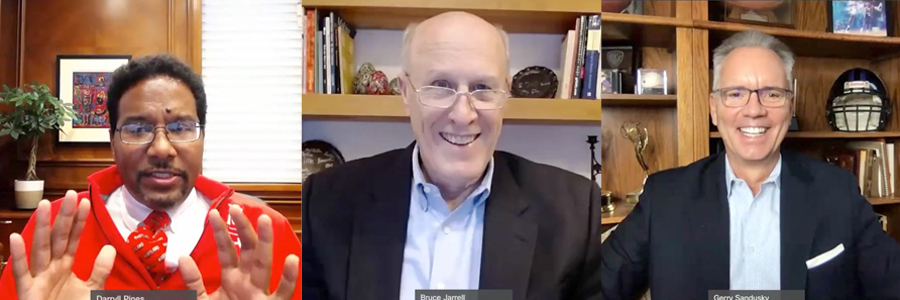November 2020
“Sport has the power to change the world. It has the power to inspire, it has the power to unite people in a way that little else does.” Former South Africa President Nelson Mandela spoke those words 20 years ago, hearkening back to his use of rugby to help unify a severely divided country post-apartheid.
In 1995, South Africa hosted the Rugby World Cup. Rugby, at that time, was seen as a white person’s sport. The national team, the Springboks, included just one non-white player. Even so, when the team won the championship, President Mandela, who had spent nearly three decades as an anti-apartheid political prisoner, walked onto the field wearing a Springboks jersey to congratulate the team, sending the message that the victory belonged to all South Africans. And that message was received.

(l-r) Darryll Pines, Bruce Jarrell, and Gerry Sandusky
In the United States, sports play a huge role in our lives. We spend more than $70 billion a year on sports. We often live vicariously through sports, reveling in what political columnist George Will called “vivid examples of excellence.” We bond over Purple Fridays and tailgate parties. We use sports to help motivate ourselves to good health. And for many of us, of course, whether it’s kicking, throwing, or smacking a ball, running or biking, or skating or snowboarding, sports are just a great way to relieve stress and burn off excess energy.
Without a doubt, this pandemic-dominated year has been like no other for the sporting world. The 2020 Summer Olympics in Tokyo was rescheduled to 2021. The NCAA canceled its “March Madness” basketball tournament for the first time in 81years. Even the Little League World Series could not be held due to the coronavirus.
But at the same time, legions of owners, players, and sports enthusiasts did find ways to continue through a combination of enhanced safety measures and temporary postponements.
The NBA played its games in a “bubble.” The battle over Lord Stanley’s Cup wasn’t finished until September. A jumbled Triple Crown brought us the Preakness Stakes in October. And Major League Baseball played just 60 regular-season games — just over one-third of the usual schedule.
As the number of new COVID-19 cases rises, so too are questions about what’s ahead. The NFL has had to postpone 12 games due to infection. Even shortened schedules and reduced travel haven’t been enough to keep college football players completely out of harm’s way. Three Southeastern Conference games are postponed this weekend, including the highly anticipated Alabama-LSU matchup.
And on Wednesday, the University of Maryland, College Park (UMCP) suspended all football activities as eight players tested positive for the coronavirus over a seven-day period. The university also canceled Saturday’s scheduled game against third-ranked Ohio State.
On the Nov. 12 edition of Virtual Face to Face with President Bruce Jarrell, UMCP President Darryll J. Pines, PhD, MS, and WBAL-TV sports director Gerry Sandusky joined University of Maryland, Baltimore President Bruce E. Jarrell, MD, FACS, to discuss sports during the COVID-19 pandemic.
“I’ve been supremely impressed, Dr. Jarrell, with how the NFL has gone about facing coronavirus,” said Sandusky who works closely with the Baltimore Ravens NFL team. “They’ve tiered everybody in the organization. You’re either Tier 1, Tier 2, or Tier 3.”
The first tier, he explained, includes players, coaches, and game-day field staff. The second tier includes the team’s support staff. Tier 3 is made of up journalists and others who never need to be in direct contact with members of the first two tiers. Tier 1 and 2 personnel wear contact tracing bracelets that alert them and team staff if they get too close to members of another tier or spend too much time in close proximity with a member of the same tier. “So they’re using technology to implement common sense,” Sandusky said.
The approach to safety in college sports has been just as rigorous, Pines explained, albeit without that level of technological support. “We made a decision in early August to forgo fall sports,” Pines said. “We did not have consistent testing protocols or contact tracing protocols, and we had differences in how we administered tests at the 14 institutions across the Big Ten, and we were like, ‘How are we going to make this work?’ ”
A few weeks later, Pines explained, Big Ten schools were able to implement daily antigen testing, following up positive results with more accurate PCR (polymerase chain reaction) tests to “create a clean practice field for fall sports, and then a clean playing field.”
After eight weeks without problems, daily testing Monday revealed that four players had contracted COVID-19, with four more testing positive in the next several days. Out of what he called an abundance of caution, Pines and UMCP athletic director Damon Evans suspended football activities and canceled the Ohio State game.
“We’re all upset,” Pines said. “Nobody can be more upset than me. Nobody can be more upset than our athletic director, our coaches, and our players, but it’s the right thing to do to ensure the health and safety of our students, our staff, and our coaches.”
Audience questions were nearly exclusively focused on youth and college sports. How did the panelists feel about kids playing sports alongside unmasked players? How have UMCP students responded to decisions about sports versus other aspects of college life that have been canceled? Will sports like wrestling or swimming that don’t lead to a professional track be cut to help fund new safety and testing measures for high-profile sports?
Watch the entire conversation and hear the answers to those questions and more by accessing the link at the top of the page.
Search UMB News
Sign up for UMB Alerts.



